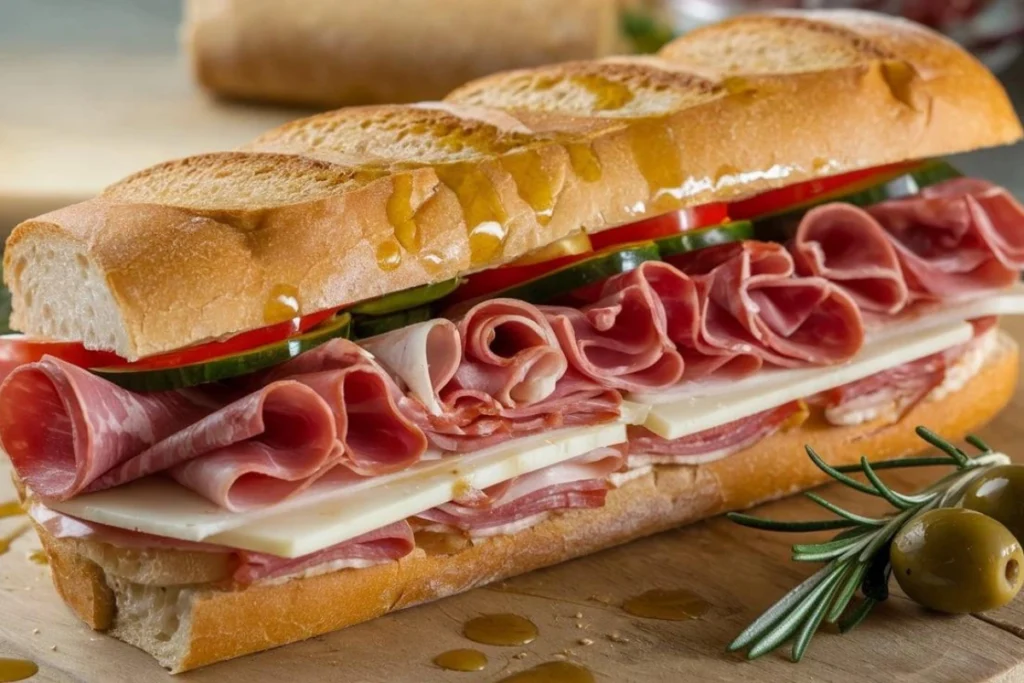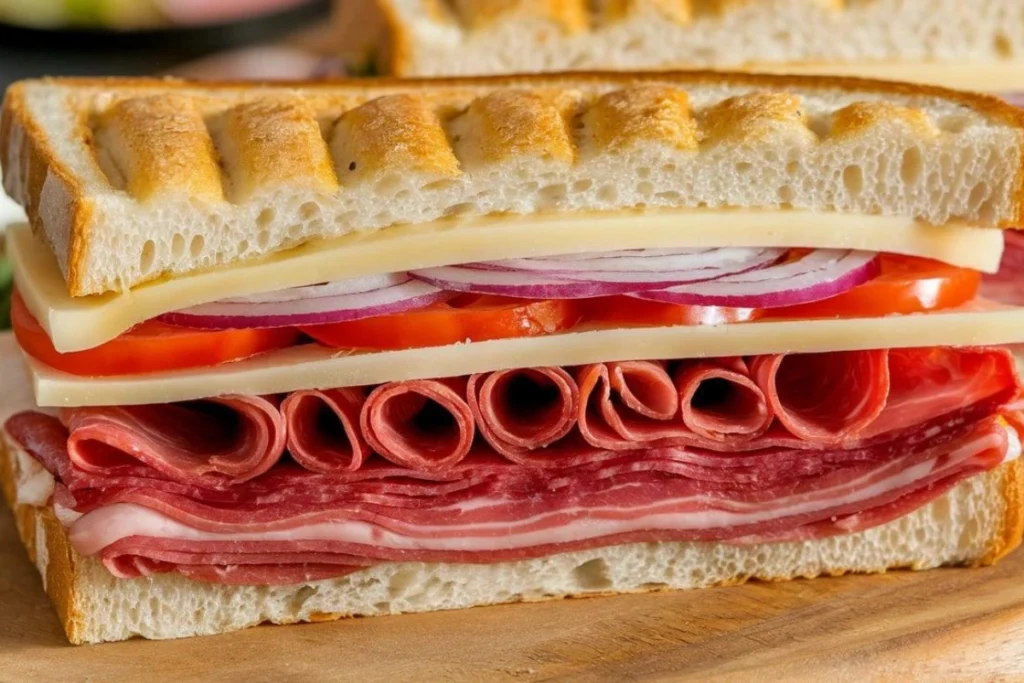Italian cuisine is known for its rich flavors, simple ingredients, and culinary traditions that have been passed down through generations. Among the many culinary delights, Italian sandwiches hold a special place. These sandwiches, known for their hearty fillings, fresh ingredients, and crusty bread, are more than just a quick meal—they are a reflection of Italy’s diverse regional food culture. But what is the name of the famous Italian sandwich that has captured the hearts of food lovers worldwide? Let’s dive into the world of Italian sandwiches, exploring their origins, variations, and cultural significance.
Introduction to Italian Sandwiches
The Italian sandwich, or panino (plural: panini), is a staple in Italian cuisine. The word “panino” literally means “small bread” in Italian, and it refers to a sandwich made from a variety of breads, typically filled with cured meats, cheeses, and vegetables. While the term “panini” is often used in English-speaking countries to describe grilled sandwiches, in Italy, a panino can be served either hot or cold, depending on the ingredients and regional preferences.
Italian sandwiches are popular not just for their delicious flavors but also for their simplicity and versatility. They can be enjoyed as a quick snack, a satisfying lunch, or even a gourmet meal, depending on the ingredients used. The cultural importance of sandwiches in Italy cannot be overstated—they are a common feature in Italian delis, street food markets, and homes across the country. For a deeper dive into the cultural aspects of these sandwiches, you can explore the history of Italian cuisine.
What is the Most Famous Italian Sandwich?
When it comes to famous Italian sandwiches, one name often stands out: the Porchetta sandwich. However, it’s important to note that the term “famous Italian sandwich” can refer to various sandwiches across different regions of Italy, each with its own unique ingredients and preparation methods.
Panino
The term “panino” is commonly used to describe any sandwich in Italy, regardless of its specific ingredients. In Italian culture, a panino is not just a type of sandwich but a symbol of Italian street food. It’s typically made with a variety of breads, such as ciabatta or focaccia, and filled with ingredients like prosciutto, mozzarella, tomatoes, and arugula.
Panini vs. Panino
There’s often confusion between the terms panini and panino, especially outside of Italy. In English-speaking countries, “panini” is used to describe a grilled sandwich, usually pressed and heated to create a warm, crispy exterior. However, in Italy, “panini” is simply the plural form of “panino.” Whether grilled or cold, a panino is cherished for its simplicity and the quality of its ingredients.
Porchetta Sandwich
Among the most iconic Italian sandwiches is the Porchetta sandwich. Originating from central Italy, particularly the Lazio region, this sandwich features porchetta—a savory, fatty, and moist boneless pork roast, seasoned with garlic, rosemary, fennel, and other herbs. This sandwich is a must-try for anyone exploring traditional Italian street food.
Regional Variations of Italian Sandwiches
Each region has its own take on the Italian sandwich, using local ingredients and traditional preparation methods.
Tramezzino (Veneto)
The Tramezzino is a popular Italian sandwich from the Veneto region. It is characterized by its soft, crustless white bread and simple fillings, which often include tuna, prosciutto, egg, or cheese. This triangular sandwich is typically served cold and is a common snack in Venetian cafés and bars.
Lampredotto (Florence)
A true Florentine specialty, the Lampredotto sandwich is not for the faint of heart. It features the fourth stomach of a cow, slow-cooked in a broth of herbs and spices, then served on a crusty roll with salsa verde (green sauce) or a spicy red sauce. The Lampredotto sandwich is a beloved street food in Florence, offering a unique taste of the city’s culinary heritage.
Piadina (Emilia-Romagna)
The Piadina is a type of flatbread from the Emilia-Romagna region, often used as a base for sandwiches. Its origins date back to ancient times, making it one of the oldest forms of bread in Italy.
Muffuletta (Sicily)
The Muffuletta sandwich, originally from Sicily, has gained international fame, particularly in New Orleans, where it was brought by Italian immigrants. This sandwich is made with a large, round sesame loaf and filled with layers of mortadella, salami, ham, provolone cheese, and a signature olive salad. The combination of flavors and textures in a Muffuletta is a testament to the influence of Italian cuisine in the United States.
Panino al Prosciutto (Nationwide)
Perhaps the most ubiquitous Italian sandwich is the Panino al Prosciutto. Found in cafés and bars across the country, this sandwich features thinly sliced prosciutto—a dry-cured ham—layered with mozzarella or provolone cheese, tomatoes, and arugula. Served on ciabatta or a similar rustic bread, the Panino al Prosciutto is a simple yet classic example of Italian culinary craftsmanship.
Ingredients that Define an Italian Sandwich
What makes an Italian sandwich truly Italian? The answer lies in the ingredients. Traditional Italian sandwiches are characterized by their use of high-quality, fresh ingredients that are often locally sourced.
Cured Meats
Cured meats are a cornerstone of many Italian sandwiches. Some of the most common cured meats used include:
- Prosciutto: A dry-cured ham that is sliced thin and known for its delicate flavor.
- Salami: A variety of salamis can be used, such as Genoa salami, which is garlicky and slightly spicy.
- Mortadella: A large, smooth-textured sausage that is flavored with spices and sometimes includes pistachios.
Cheeses
Cheese plays a vital role in Italian sandwiches, adding creaminess and flavor. Commonly used cheeses include:
- Provolone: A semi-hard cheese with a sharp, tangy flavor.
- Mozzarella: A soft cheese that is mild and melts beautifully, often used in hot sandwiches.
- Pecorino: A hard, salty cheese made from sheep’s milk, used sparingly to add a sharp, rich flavor.
For more information on the different types of Italian cheeses and their uses, check out this guide to Italian cheeses.
Breads
The bread used in an Italian sandwich is just as important as the fillings. Popular choices include:
- Ciabatta: A rustic bread with a crisp crust and airy interior, perfect for soaking up oils and dressings.
- Pane Toscano: A traditional Tuscan bread that is unsalted, often used to balance the strong flavors of cured meats and cheeses.
Condiments and Vegetables
No Italian sandwich is complete without a selection of fresh vegetables and flavorful condiments:
- Olive Oil: A staple in Italian cuisine, often drizzled over the sandwich to enhance its flavors.
- Vinegar: Typically red wine vinegar, adds acidity and brightness.
- Arugula: A peppery green that adds a fresh, bitter note.
- Tomatoes: Fresh, vine-ripened tomatoes bring juiciness and sweetness to the sandwich.

Cultural Significance of Italian Sandwiches
Italian sandwiches are more than just food—they are a reflection of Italy’s rich culinary traditions and its emphasis on simplicity and quality.
Italian Deli Culture
In Italy, the deli (or “salumeria”) is more than just a place to buy meats and cheeses. It is a cultural institution where locals gather to purchase freshly sliced prosciutto, salami, and cheeses for their sandwiches. The experience of visiting a deli and selecting ingredients is an integral part of the Italian way of life, emphasizing the importance of quality and tradition in everyday meals.
Sandwiches as Street Food
Italian sandwiches are also a popular form of street food. In cities like Florence, Rome, and Naples, it’s common to see people enjoying a quick, freshly made sandwich on the go. Whether it’s a Lampredotto sandwich in Florence or a Porchetta sandwich in Rome, these street foods offer a taste of Italy’s regional diversity and culinary heritage. To explore more about Italy’s street food culture, consider reading about the best Italian street foods.
Popular Variations of Italian Sandwiches Worldwide
The influence of Italian sandwiches has spread far beyond Italy’s borders, leading to the creation of several popular variations around the world.
Muffuletta in the United States
The Muffuletta sandwich is perhaps the most famous Italian-American sandwich. Brought to New Orleans by Sicilian immigrants in the early 20th century, the Muffuletta has become a staple in the city’s culinary scene. The key to this sandwich is the olive salad, which adds a briny, tangy contrast to the rich meats and cheeses.
Italian Submarine (USA)
The Italian Submarine, or simply “Italian Sub,” is a classic sandwich in American delis. It typically includes a combination of Genoa salami, ham, mortadella, provolone cheese, and fresh vegetables, all layered on a sub roll.
Pan Bagnat (France)
The Pan Bagnat is a French variation of the Italian sandwich, particularly popular in the Provence region. It features ingredients commonly found in a Niçoise salad, such as tuna, hard-boiled eggs, olives, and anchovies, all stuffed into a crusty baguette.
Italian Sandwiches in Modern Cuisine
Italian sandwiches have evolved over time, with modern chefs and home cooks experimenting with new ingredients and techniques to create unique takes on the classic sandwich.
Gourmet Takes on Traditional Sandwiches
In recent years, chefs have begun to put their own spin on traditional Italian sandwiches, incorporating gourmet ingredients and innovative preparation methods. For example, you might find a Porchetta sandwich topped with truffle aioli, or a Panino al Prosciutto with fig jam and arugula. These gourmet versions elevate the humble sandwich to a fine dining experience.
Vegetarian and Vegan Italian Sandwich Options
As the demand for plant-based options grows, more vegetarian and vegan variations of Italian sandwiches are appearing on menus. These sandwiches often feature roasted vegetables, plant-based cheeses, and innovative spreads, ensuring that everyone can enjoy the flavors of Italy.
Fusion Sandwiches
Fusion sandwiches combine Italian ingredients with flavors from other cuisines, creating exciting new dishes. For example, a sandwich might feature prosciutto and mozzarella with a spicy Sriracha mayo, or mortadella paired with kimchi. These fusion creations reflect the global influence of Italian cuisine and the endless possibilities for culinary creativity.

FAQs About the Famous Italian Sandwich
What is the difference between a panino and a panini?
In Italy, a panino refers to a single sandwich, while panini is the plural form, meaning multiple sandwiches.
Can I make traditional Italian sandwiches at home?
Absolutely! Making traditional Italian sandwiches at home is simple and rewarding. All you need are high-quality ingredients such as fresh bread, cured meats, cheeses, and vegetables. Assemble the sandwich with care, and consider toasting it lightly to enhance the flavors.
What is the best bread for Italian sandwiches?
The best bread for Italian sandwiches varies depending on the type of sandwich. Ciabatta is a popular choice for its airy texture and crisp crust, while focaccia offers a soft, herb-infused base. For a more rustic sandwich, pane Toscano provides a dense, chewy texture that complements strong flavors.
What are the most popular Italian sandwiches outside Italy?
Outside of Italy, some of the most popular Italian sandwiches include the Muffuletta in New Orleans, the Italian Submarine in American delis, and the Pan Bagnat in France. These sandwiches reflect the global appeal of Italian flavors and the adaptability of the sandwich format.
Conclusion
The famous Italian sandwich is not just a meal—it’s a celebration of Italy’s rich culinary traditions. Whether you’re enjoying a Porchetta sandwich on the streets of Rome, a Tramezzino in a Venetian café, or a Muffuletta in New Orleans, these sandwiches offer a taste of Italy’s diverse food culture. By understanding the ingredients and regional variations that define these sandwiches, you can appreciate the artistry that goes into each bite.

